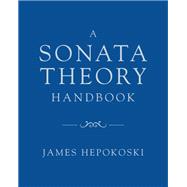Sonata form is the most commonly encountered organizational plan in the works of the classical-music masters, from Haydn, Mozart, and Beethoven to Schubert, Brahms, and beyond. Sonata Theory, an analytic approach developed by James Hepokoski and Warren Darcy in their award-winning Elements of Sonata Theory (2006), has emerged as one of the most influential frameworks for understanding this musical structure. What can this method from "the new Formenlehre" teach us about how these composers put together their most iconic pieces and to what expressive ends?
In this new Sonata Theory Handbook, Hepokoski introduces readers step-by-step to the main ideas of this approach. At the heart of the book are close readings of eight individual movements — from Mozart's Piano Sonata in B-flat, K. 333, to such structurally complex pieces as Schubert's "Death and the Maiden" String Quartet and the finale of Brahms's Symphony No 1 — that show this analytical method in action. These illustrative analyses are supplemented with four updated discussions of the foundational concepts behind the theory, including dialogic form, expositional action zones, trajectories toward generically normative cadences, rotation theory, and the five sonata types. With its detailed examples and deep engagements with recent developments in form theory, schema theory, and cognitive research, this handbook updates and advances Sonata Theory and confirms its status as a key lens for analyzing sonata form.








